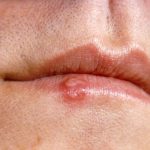 A recurrent, small blister in and around the mouth caused by the herpes simplex virus.
A recurrent, small blister in and around the mouth caused by the herpes simplex virus.
Fever blister caused by herpes simplex virus, occurring on the skin or mucous membranes (e.g., at the comer of the mouth).
Popular name for mouth sores caused by the herpes simplex virus.
A small, highly contagious blister around the mouth caused by the herpes simplex virus; also known as a fever blister. Although factors, such as stress, sun exposure, fever, injury, colds, or other illness, can trigger an outbreak, one can occur without an apparent trigger. Cold sores frequently affect adolescents and young adults. Blisters tend to recur at the same site and usually appear on the lips but may also develop on the cheeks, chin, nostrils, or gums.
Thin-walled blister at the junction of the mucous membranes of the mouth and lips, caused by recurrent infection with herpes simplex virus (HSV) in persons who already have antibodies to HSV. Treatment is recommended only for immunocompromised patients, who are given acyclovir.
A diminutive blister appearing on the lips or face, resulting from a viral infection. It is commonly referred to as a fever blister.
A small blister that typically appears on the skin, often around the mouth, is commonly known as a cold sore. This condition is usually caused by a strain of the herpes simplex virus called HSV1 (herpes simplex virus type 1).
During the initial infection, the herpes simplex virus may not produce any noticeable symptoms in some individuals. However, in other cases, it can result in a flu-like illness characterized by painful ulcers in the mouth and on the lips, a condition known as gingivostomatitis. Following the initial infection, the virus enters a dormant phase within nerve cells but can occasionally reactivate, leading to the formation of cold sores.
The reactivation of the herpes simplex virus can be triggered by various factors, such as exposure to intense sunlight or cold winds, the presence of a common cold or other infections, or in women around the time of their menstrual cycles. Individuals with weakened immune systems due to illness or the use of immunosuppressant drugs may experience prolonged episodes of viral activity.
Often, the onset of cold sores is heralded by a tingling sensation on the lips, which is followed by the development of small blisters. These blisters gradually enlarge, leading to itching and discomfort. After a few days, the blisters rupture and form crusts. In most cases, cold sores resolve within a week and gradually fade away.
The application of aciclovir, an antiviral medication in cream form, at the initial sensation of tingling, can potentially help prevent the occurrence of cold sores.
Cold sores, also known as herpes labialis, are believed to be caused by a virus that resides in the skin. These sores initially appear as blisters around the mouth and eventually turn into crusted ulcers. Treatment often involves frequent application of surgical spirit, followed by an antibiotic cream. The same antibiotic might also be applied to the nostrils, as the virus often resides there as well. Some people have found success in preventing cold sores through weekly smallpox vaccinations over several weeks, although the reason for this treatment’s effectiveness is not fully understood.
